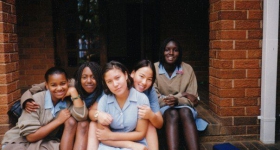Illustrator Junichi Tsuneoka
There’s a graveyard full of media companies that have tried to cash in on the lucrative but hard to crack Asian American market, a fragmented demographic group with numerous ethnicities, cultures, races and languages.
But in the last year, MTV has been trying something different, eschewing the shotgun pan-Asian approach and going for the niches within. The network launched two ethnic-specific channels: MTV Desi marketed to South Asians, and MTV Chi (like “tai chi”) targeting Chinese Americans.
Young Asian and Pacific Islanders in MTV’s audience didn’t live through the Asian American movement of the ’60s and ’70s, and they may identify more with their ethnic or national background than a pan-Asian identity.
“It’s really difficult to serve all languages, generations and ethnicities,” says Donald Young, interim director for the Center for Asian American Media. “If you can pull off the pan-Asian American channel, you might as well. But I think (MTV) figured out that it’s not viable. They have the resources to look into it and test it out.”
MTV’s brand of super-serving a single audience contrasts the efforts of pan-Asian television networks like AZN and ImaginAsian which also launched in the last year. Both AZN and ImaginAsian have struggled to attract audience and advertising, and it’s too early to tell if MTV’s approach will be more successful.
Young Asian Americans want to see channels like MTV Chi and MTV Desi, according to Nusrat Durrani, senior vice president of MTV World, which oversees these channels. “They haven’t seen themselves enough on television, particularly in popular culture.”
Durrani says one thing they considered in choosing the ethnic groups to focus on is the popular culture coming from their home countries. “Is there a pop culture from these ethnic groups that’s exploding? Is it happening?” he asks.
Much of the programming is repackaged from MTV’s 108 other worldwide channels, with you-name-it-pop. On MTV Desi, you can vote for Eminem, M.I.A., Cold Play or Bohemia the Punjabi Rapper for the Top 10 Countdown.
MTV Desi includes MTV Desi News, with a lot of Bollywood-influenced segments (Bollywood on Ice, Immies, Style Awards), a reality show on MTV India called Roadies, Cameron Diaz’s Trippin’ and other programs.
On MTV Chi’s Top 10, Jay Chou videos are thrown in with Kanye West, Madonna, Jin and some Asian American bands.
“We play a lot of music that isn’t Chinese, but it all needs to be able to connect with young Chinese Americans,” Durrani says of MTV’s strategy for its ethnic channels. “That’s the filter.”
Durrani seems earnest in his attempt to cater to the audience. There’s a place on the channels’ websites to upload independently made music videos, and he urges people to submit suggestions on what they’d like to see. A vote on the website picked the first video shown on MTV Chi in December 2005, Jin’s Learn Chinese.
Perhaps the most refreshing program on the channel is the Live From segments, where a guest star VJ gives audiences a tour of his or her stomping grounds. In one Live From, Jin leads viewers through the streets of New York’s Chinatown. He’s natural and charismatic, as are the regular VJs on MTV Desi and MTV Chi (see chart).
In the end, though, it’s about the bottom line. If MTV doesn’t make money off of these channels, then they won’t be around for long. The channels are available through the DirectTV satellite service, but Durrani says he can’t disclose how many people have signed up. MTV K for Korean Americans is slated to launch in 2006, and a fourth, yet-unrevealed ethnic channel is in the works.
“It’s really tough because communities want to believe, hope or expect that these huge media conglomerates will have some level of social responsibility,” says Young of the Center for Asian American Media. “But since it’s not really mandated, how much good are they really going to do?”










Comments